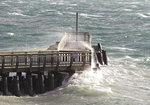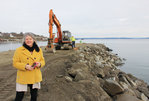The Port of Port Townsend is launching a process, intended to include a community discussion, to determine what can be done to save Point Hudson.
“Save” as in help the public port district …
This item is available in full to subscribers.
We have recently launched a new and improved website. To continue reading, you will need to either log into your subscriber account, or purchase a new subscription.
If you had an active account on our previous website, then you have an account here. Simply reset your password to regain access to your account.
If you did not have an account on our previous website, but are a current print subscriber, click here to set up your website account.
Otherwise, click here to view your options for subscribing.
* Having trouble? Call our circulation department at 360-385-2900, or email our support.
Please log in to continue |
|


The Port of Port Townsend is launching a process, intended to include a community discussion, to determine what can be done to save Point Hudson.
“Save” as in help the public port district figure out how to pay for an estimated $5 million in repairs to the Point Hudson jetty, without which the marina could close. Even with the jetty repaired, the port is dealing with sobering financial issues.
“We do not have a viable financial plan to replace the Point Hudson jetty to protect our whole identity of maritime heritage,” Sam Gibboney, port executive director, told The Leader Jan. 13. “That is an issue that we as a community need to address.”
Gibboney estimates the port needs an annual income of $500,000-$600,000 at Point Hudson, and does not see that happening with the current mix of a 32-slip marina, 48-stall RV park and tenant leases on 80-year-old buildings.
“We lose money,” she said about Point Hudson. “The property as a whole – we lose money on it.”
Gibboney is to lead a port staff meeting Jan. 19 with a consulting firm, and has a Jan. 20 meeting with City of Port Townsend Manager David Timmons and Jake Beattie, executive director of the Northwest Maritime Center (NWMC). The port commission discussed the situation during its retreat earlier this month, she noted.
Hired last spring, Gibboney has been blunt about the port’s financial situation, particularly the costs of deferred maintenance, and how the “status quo” is not sustainable.
Gibboney lists three “mission critical” projects: replace the Point Hudson jetty; repair the Port Townsend Boat Haven breakwater to protect the heavy haul-out operation and 475-slip moorage; and improve boatyard stormwater treatment. “If we do not address them, catastrophic failures could close facilities and halt business operations,” she said.
The NWMC relies on the Point Hudson Marina to serve its maritime education programs. It’s also home to the Wooden Boat Festival – the largest festival in Jefferson County – which is the nonprofit entity’s primary fundraiser.
“There is no question that Point Hudson is a net contributor to the health and reputation of this community, and it’s a cultural center for not just the Wooden Boat Festival, but for traditional marine trades,” Beattie said. “The port has an interesting challenge in that those huge community benefits largely don’t hit their financial bottom line.”
CHOICES TO MAKE
Pete Hanke Jr. of Port Ludlow is port commission president and also a business tenant at Point Hudson, where his family’s Puget Sound Express whale-watching operation is based.
“If we rebuild this breakwater, and it maintains the small marina, which in no way is ever going to pay for that [jetty] replacement cost, then you can’t do other things like enhance the shipyard or the boatyard to create more jobs,” Hanke said. “Maybe you’re not going to have any matching funds to do an agriculture project out in Center Valley, for example, or to deal with Quilcene [marina], where a lot of things need to be addressed.
“I’m not saying we won’t and I’m not saying we shouldn’t; the permit and planning is already underway,” Hanke said of the jetty. “We are really having a soul-searching conversation as to the why, and the feeling that it needs to be a community-wide event to make it work. It’s going to limit us in what we can do with our public assets down the road.”
A timeline is to be developed that would include public meetings to seek “active engagement of our stakeholding tenants and the community,” Gibboney said. Building partnerships does not necessarily mean asking agencies or businesses for money, she noted.
“The community has a much greater sense of access and ownership of Point Hudson. That’s a good thing, but we need to make sure we articulate the real crisis we are in,” Gibboney said.
DEVELOPMENT OPTIONS
The port’s financial bonding capacity is limited, thanks to self-funding projects such as the 2005 remodel of a former motel at Point Hudson into port administrative offices. Those offices are now leased to state and federal agencies, after the port used more of its bonding capacity in 2013 to construct an office building at the Port Townsend Boat Haven. The port’s bond debt service requirements are substantial: at least $1 million a year through 2025.
The port’s projected property tax levy revenue for 2017 is $965,000.
Changing business operations at Point Hudson starts with zoning rules. Point Hudson has its own section in the city’s shoreline master program, with the area specifically designated to support marine trades. Existing, nonconforming uses, such as the RV park, are allowed; an expanded RV park would not be permitted. New construction would be allowed, subject to design review. Full-time housing is not a permitted use, according to John McDonagh, senior planner with the City of Port Townsend’s Department of Community Development.
Hanke said the commission believes that the county, city and port governments should work together to find solutions.
“We’re not trying to be adversarial,” Commissioner Hanke said of the idea that the port may seek financial or other support from city and county government and/or businesses and nonprofit operations. “For a large majority of the people of Jefferson County, they have no idea what is going on with the [Point Hudson] breakwater, and the costs of the current facility. It is a public asset, and we really have our backs against the wall.”
JETTY REPLACEMENT
The Point Hudson breakwater jetty on Port Townsend’s waterfront was constructed in 1934, when the federal government dredged a boat basin for its new quarantine station, which evolved into a U.S. Coast Guard training center. The port district acquired the property as government surplus in the 1950s. In 1972, new rows of wooden creosote piles were added outboard of the original jetty piles. In 1995, new horizontal steel cable ties between the tops of all the 1972 piles were added to increase stability. The timber-framed walkway was added in 1995.
According to a 2013 engineer’s report, the repair work completed in 1972 is holding the breakwater together. The steel cable ties have severe rust, and some wires are breaking. The wooden walkway is uneven and twisted.
The engineer suggested the jetty could handle “normal” storms over the next few years, but a “normal” storm could also damage the areas in the worst repair and cause a potential collapse.
“If we don’t fix the jetty, it will fail and it’s not a far-off proposition,” Gibboney said.
The port is proceeding with the permit and planning paperwork for jetty replacement, but has postponed the project’s first stage one year to 2018-2019, Gibboney said.
Once the jetty work gets underway, there would be no boat access. The marina provides access to SEA Marine’s boat haulout, the Puget Sound Express whale-watching boats, seasonal transient moorage, small boats and kayaks.
Beattie, as he watched from his NWMC office as wind-whipped waves pummeled the shoreline on the morning of Jan. 17, knows that time is not on the jetty’s side.
‘If what the engineers say is true, the odds don’t get better the more it gets delayed,” Beattie said of the jetty repairs.
OTHER REPAIRS
There are various maintenance issues at Point Hudson. Repairs were made last year that included a second-story fire escape on the Armory Building (the sail loft), and other fire-safety issues still need to be addressed, Gibboney said.
The port’s 2017 capital project list includes design and installation of ventilation equipment for the administration building. Built in the 1930s, the structures sit on creosote-coated pilings. When renovated in 2005, vapor barrier sheathing and mechanical ventilation were added to mitigate the creosote odor. The measures have been fairly successful, but “resolving this issue is key to the viability of long-term commercial leasing at this and other Point Hudson facilities,” according to the port budget report. Cost is estimated at $110,000, with the funding source being unreserved cash.
Point Hudson asbestos remediation is estimated to cost $93,000, with the funding source being unreserved cash.
Gibboney cautioned, “Our capital improvement needs will consume any surplus or income from operations for years to come.”
While the port has plans and cash to cover basic maintenance, port officials want input on how to preserve the public asset.
“Point Hudson is easily the most prime piece of property in the entire Puget Sound,” Hanke said. “We, the citizens of Jefferson County, owe it to ourselves to figure out how to effectively maintain it.”